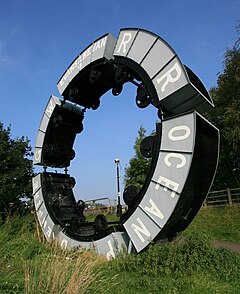Maesycwmmer
Maesycwmmer
|
|
|---|---|
 Wheel o Drams by Andy Hazell |
|
| Maesycwmmer shown within Caerphilly | |
| Population | 2,242 (2011) |
| OS grid reference | ST1594 |
| Community |
|
| Principal area | |
| Ceremonial county | |
| Country | Wales |
| Sovereign state | United Kingdom |
| Post town | HENGOED |
| Postcode district | CF82 |
| Dialling code | 01443 |
| Police | Gwent |
| Fire | South Wales |
| Ambulance | Welsh |
| EU Parliament | Wales |
| UK Parliament | |
| Welsh Assembly | |
Maesycwmmer (Welsh: Maesycwmer) is a village and community in the centre of Caerphilly County Borough in Wales, within the historic boundaries of Monmouthshire.
Some have claimed that the village name should be spelled as Maes-y-Cymer, meaning "the field of the confluence of streams". As Maesycwmer, however, the name is probably derived from Maes (field) + cwmwr (footbridge). A local tradition holds that a large tree was blown down during a storm, forming a natural footbridge across the river. The footbridge was used by noted preacher and local pioneer of the printing press, the Rev. John Jenkins (also known as Shôn Shincyn), to cross the river to his house. Jenkins' house "Maesycwmmwr House" was built in 1826 and stood on the east side of the river. In the 1840 Tithe Map for the village is given as Maesycwmwr, with the spelling then varying to Maesycwmer over time.
Maesycwmmer is located 5 miles (8 km) north of Caerphilly, on the east bank of the Rhymney River, opposite Hengoed, which is within the historic boundaries of Glamorgan. It is a community in Caerphilly County Borough.
Maesycwmmer is still overshadowed by the vast Maesycwmmer Viaduct, which dates from 1853 and which carried the Taff Vale Extension of the Newport, Abergavenny and Hereford Railway over the Rhymney valley. In 2000 the viaduct was re-opened for public pedestrian access.
Today the village features the "Wheel o Drams" (locally known as "The Stargate") sculpture by Andy Hazell, an unusual piece of modern art formed from a circle of coalmining dram trucks to commemorate the industrial heritage of this locality within the history of the South Wales Valleys. The village shared three railway stations with neighbouring Hengoed over the years (see Hengoed railway station).
...
Wikipedia

